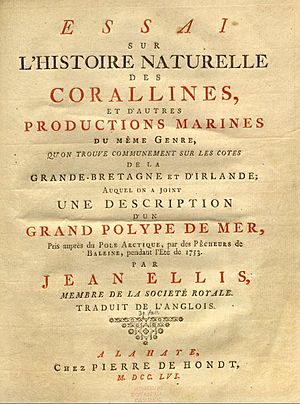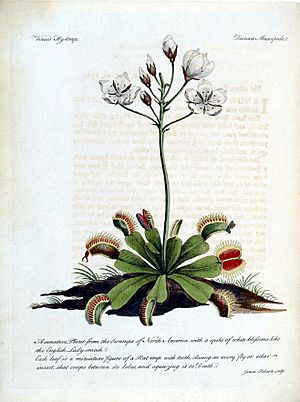John Ellis (naturalist) facts for kids
Quick facts for kids
John Ellis
|
|
|---|---|
| Born | c. 1710 |
| Died | 15 October 1776 (aged 65–66) |
| Occupation | Naturalist, linen merchant |
| Awards | Copley Medal 1767 |
John Ellis (around 1710 – 15 October 1776) was a British naturalist. A naturalist is someone who studies nature, like plants and animals. He was also a linen merchant, which means he bought and sold linen fabric.
John Ellis was the first person to write a detailed description of the amazing Venus flytrap plant. He also gave it its scientific name. He was very interested in studying corals, which are tiny sea animals that build hard skeletons.
In 1754, Ellis became a member of the Royal Society. This is a famous group for scientists. The next year, he published a book about corals called An essay towards the Natural History of the Corallines. In 1767, he won the Copley Medal, a very important science award.
Ellis also worked as a Royal Agent for British areas in North America and the Caribbean. He sent many seeds and native plants from North America back to England. He wrote letters to many other botanists, including the famous Carl Linnaeus.
Discovering the Venus Flytrap
The Plant That Eats Insects
John Ellis played a big part in introducing the Venus flytrap to the world. A royal botanist named William Young brought live Venus flytrap plants to England. He then showed them to Ellis.
In 1769, Ellis wrote a description of this unique plant. He sent his notes to Carl Linnaeus, who is known as the "Father of Taxonomy." Taxonomy is the science of naming and classifying living things.
Ellis also gave the plant its scientific name: Dionaea muscipula. Later, in his book Directions for bringing over seeds and plants, from the East Indies (1770), he included the very first drawing of a Venus flytrap. This helped people understand what the plant looked like.
Honours and Legacy
John Ellis was honored for his work in botany. Two different plant genera (groups of plants) were named after him. One was Ellisia, named in 1763. The other was Ellisiophyllum, named in 1871. This shows how important his contributions were to the study of plants.
See also



